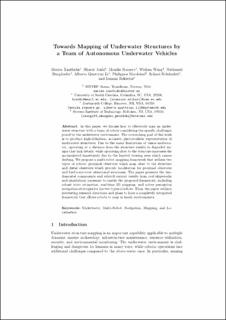| dc.contributor.author | Xanthidis, Marios | |
| dc.contributor.author | Joshi, Bharat | |
| dc.contributor.author | Roznere, Monika | |
| dc.contributor.author | Wang, Weihan | |
| dc.contributor.author | Burgdorfer, Nathaniel J. | |
| dc.contributor.author | Quattrini Li, Alberto | |
| dc.contributor.author | Mordohai, Philippos | |
| dc.contributor.author | Nelakuditi, Srihari | |
| dc.contributor.author | Rekleitis, Ioannis | |
| dc.date.accessioned | 2023-03-09T14:30:12Z | |
| dc.date.available | 2023-03-09T14:30:12Z | |
| dc.date.created | 2023-03-08T13:00:31Z | |
| dc.date.issued | 2023 | |
| dc.identifier.citation | The International Symposium of Robotics Research, ISRR 2022: Robotics Research, 170-185 | en_US |
| dc.identifier.isbn | 978-3-031-25555-7 | |
| dc.identifier.uri | https://hdl.handle.net/11250/3057442 | |
| dc.description.abstract | In this paper, we discuss how to effectively map an underwater structure with a team of robots considering the specific challenges posed by the underwater environment. The overarching goal of this work is to produce high-definition, accurate, photorealistic representation of underwater structures. Due to the many limitations of vision underwater, operating at a distance from the structure results in degraded images that lack details, while operating close to the structure increases the accumulated uncertainty due to the limited viewing area which causes drifting. We propose a multi-robot mapping framework that utilizes two types of robots: proximal observers which map close to the structure and distal observers which provide localization for proximal observers and bird’s-eye-view situational awareness. The paper presents the fundamental components and related current results from real shipwrecks and simulations necessary to enable the proposed framework, including robust state estimation, real-time 3D mapping, and active perception navigation strategies for the two types of robots. Then, the paper outlines interesting research directions and plans to have a completely integrated framework that allows robots to map in harsh environments. | en_US |
| dc.language.iso | eng | en_US |
| dc.publisher | Springer | en_US |
| dc.relation.ispartof | Robotics Research | |
| dc.title | Towards Mapping of Underwater Structures by a Team of Autonomous Underwater Vehicles | en_US |
| dc.title.alternative | Towards Mapping of Underwater Structures by a Team of Autonomous Underwater Vehicles | en_US |
| dc.type | Chapter | en_US |
| dc.type | Peer reviewed | en_US |
| dc.description.version | acceptedVersion | en_US |
| dc.rights.holder | This is a post-peer-review, pre-copyedit version of an article published in ISRR 2022: Robotics Research. The final authenticated version is available online at: http://dx.doi.org/10.1007/978-3-031-25555-7_12 | en_US |
| dc.source.pagenumber | 170-185 | en_US |
| dc.identifier.doi | 10.1007/978-3-031-25555-7_12 | |
| dc.identifier.cristin | 2132359 | |
| cristin.ispublished | true | |
| cristin.fulltext | postprint | |
| cristin.qualitycode | 1 | |
